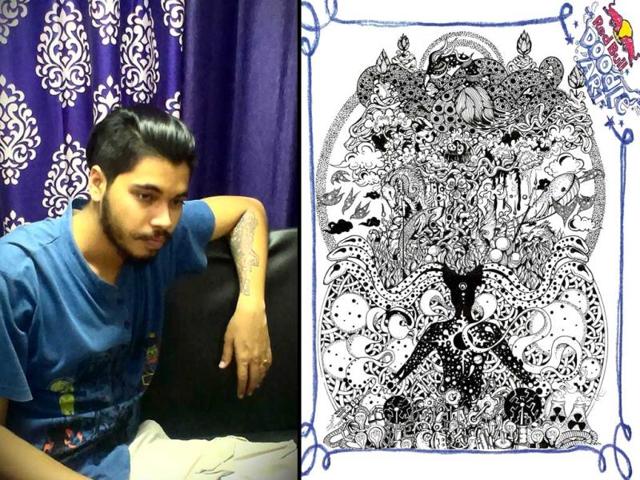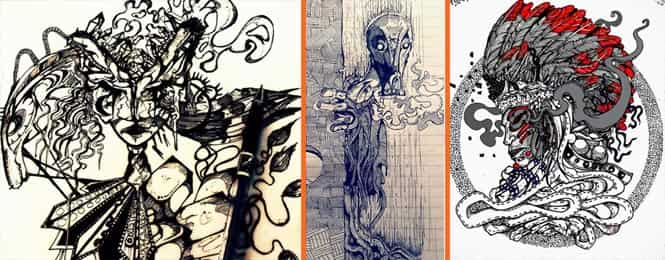Doodling his way to fame: Assam boy to represent country in doodling competition
Santanu Kaushik Hazarika, the India winner of the Red Bull Doodle Art, speaks to Hindustan Times, about the winning art piece, how he doodles and what doodling exactly means. Santanu will represent India in the final international round, in Cape Town in October.
A human figure, sketched in black, sits meditating while the entire plant and animal kingdom sprouts out of its head. And of all that comes out of the brain, the most striking are the six dotted snakes. Drawing profusely from Hindu mythology, this intricately detailed art piece by Santanu Kaushik Hazarika is the India winner of the Red Bull Doodle Art, a global art project involving student artists.

The Red Bull Doodle Art project is all the more important since it's one of the 460 projects of this year's World Design Capital -a biennial designation awarded by the International Council of Societies of Industrial Design (ICSID), an international non-profit society founded in 1957 which focuses on promoting better urban and industrial designs across the world.
The 'World Design Capital' for the period 2014-16 has been awarded to Cape Town. Hence Santanu Kaushik Hazarika is all set to represent India in the finals of the doodling event, amongst winners from around 30 participating countries, covering 50 art markets, from October 24 to 26, in Cape Town.
A doodle is often described as an absent-minded scribble. 'Doodle' usually refers to drawings produced when the artist is 'unfocused' or 'unconscious' regarding what design or shapes he is making on the paper. However, Sunni Brown, a visualisation expert, known for her large-scale live content visualizations, delivered a now famous TED talk, 'Doodlers, Unite!', in which she emphasized that 'doodling is deep thinking in disguise and that it is a simple, accessible tool for problem-solving in general'.
The winning piece
Santanu, a 23-year-old engineering student in Guwahati, Assam, speaks to Hindustan Times, about the winning piece, how he doodles and what doodling exactly means.
Tell us something about the winning piece.
This doodle is an outcome of a few books on Hinduism that I have been reading of late, especially those by Devdutt Pattanaik. This piece is influenced by the symbolism mentioned in Hindu texts. You can see a human figure with a large head sprouting out 6 snakes, acting like nature's base. Well this was inspired by Vishnu and Brahma, the 6 headed snake being Adi-Ananta-Sesha. These things came randomly because my mind was preoccupied with a lot of analogies. The doodle is minutely detailed, and when you zoom into it, a lot of ideas may come out of it.

Detailed art pieces by Santanu Kaushik Hazarika
So how did doodling come to you? I mean we all used to scribble and make figures in between taking notes during lectures, but to pursue this art form at a completely professional level… I started doodling when I was a kid. But back then I wasn't much into art. I would doodle during classes and in buses--basically whenever I felt bored. Since I'm a self-taught artist I had no proper idea about drawing and things that are involved in it, so I would just draw freehand and keep on scribbling things hoping to give it some form. Slowly, I got good at it. I like doodling because it's a perfect way to take on random yet significant things, develop a deeper imagery and compile them with the help of symbolism.
Doodling, Wikipedia says, 'is an unfocused or unconscious drawing made while a person's attention is otherwise occupied'. But going by your winning piece it's hard to believe that it was not pre-conceived before the artist put his pen onto paper. So do you draw randomly? Or are they planned?
Yes, my doodles are conceptualized. See, the thing is you can't simply draw random things. Since you are doodling that is drawing subconsciously some idea or the other has to be at the back of your mind. And these ideas or concepts are the reflection of your thoughts. When I draw, I start off completely blank with no idea whatsoever. The first step for me is always a dot and then you keep on improvising until you think you have done enough. Even in the Red Bull winning piece, I started from a point and ended up, unknowingly, with the man-universe form.
So how's doodling different from other kinds of visual graphics? What sets it apart?
Normal graphic art has a destination; you have an idea about its outcome. And it's done electronically, most of the time, using software like Adobe Photoshop and Adobe Illustrator. Moreover, graphic art is a very broad category which includes photography, printmaking, lithography, typography, and even serigraphy. It requires focus unlike doodling. But according to me since doodling is becoming a recognised art form, it will also become a graphic thing.
The Russian novelist Alexander Pushkin's notebooks and Rabindranath Tagore's manuscripts are famous for doodles. And, of course, Google has made the term 'doodles' quite trendy, with the interesting graphics on special occasions. Has 'Google doodles' influenced the rise of doodling as a mainstream art? Who are the doodle artists that you look up to?
Yes, in a way, 'Google doodle' has made an impact. Well, artists I look up to… can't call them exactly doodle artists… but there are a few who are really good at it. For example, take Kerby Rosanes. He has given this art form a whole new face. In India, there is Gaurav Basu who is popularly known as 'acid toad' and Shraddha Trivedi.





